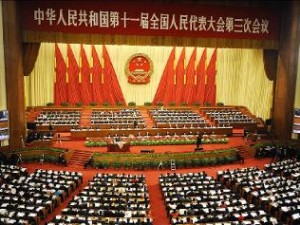Chinese Peoples Political Consult Conf.
Brian Hennessy. An Australian in China. October, 2009.
The Chinese People’s Political Consultative Conference (CPPCC) was formed on the 21st September 1949, and was meant to be composed of people who represented the various sectors of Chinese society. The original aim was for it to be an instrument cooperation and political consultation led by the Communist Party.
The Chinese Peoples Political Consultative Conference (CPPCC) 2009
_____________________________________________________________
Today, the Party claims that this conference is evidence of ‘democratic centralism’ in action. The fact is, however, that the CPPCC is an advisory body only. The party is not bound to take note of its recommendations.
So nobody was surprised when President Hu Jin Tao, in his keynote address to the CPPCC this year, instructed the 800 CPPCC delegates to: persist in promoting intra-party democracy (whatever that means) and to strengthen solidarity (whatever that means also).
More specifically: he stated that the two overriding missions of the CPPCC were: (i) settling ethnic conflicts; and (ii) reducing social confrontation. More a ‘top-down’ than a ‘bottom-up’ approach wouldn’t you say?
Thus one is entitled to ask the following rhetorical questions: where is the ‘consultation’ in the CPPCC? And how can this body of representatives claim to be contributing to democratic centralism?
More encouragingly, president Hu spoke of the wide disparity between rich and poor nationwide, and instructed the delegates to address and reflect on the aspirations of the different levels of society; and to help the party and the government allocate resources among the various sectors of society more fairly.
Fine sentiments. More general policy from the lawmakers at the top which will be routinely ignored by local cadre at the bottom. These pronouncements need regulatory teeth. A street-wise public which is fed up with government graft and corruption refuses to be taken in by primitive propaganda.
Hence the increase in ‘social confrontation’ these days against corrupt local officers in corrupt local county governments. Never mind the Tibetans and the Uighurs, the real problem is home-grown ‘social instability’ amongst Han Chinese people themselves.
More disappointing for those of us who had hoped for some regulatory teeth to the expected platitudes about corruption and so on, were pre-conference media leaks informing the public that government officers might have to publically declare their pecuniary interests.
This proved to be a false hope. A long hoped-for regulation requiring government members to publicly register their financial interests was watered down to a recommendation for within-government registration only. Cynics would argue that this information would more likely be used as a weapon between competing factions of government rather than as a tool for rooting out the cancer of corruption.
It is this sort of self-protective behaviour which emboldens the cynics and socially-disruptive elements of society and adds credence to one Beijing academic’s claim that “corruption is a recruiting tool” of the Party.
China is contradictions. One the one hand we have another highly publicized anti-corruption campaign which has snared some very high profile people; and on the other, we have a refusal by government to countenance systemic change. Change which would tackle the culture of corruption at its roots. It’s all done with mirrors, folks.
.

